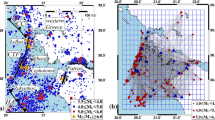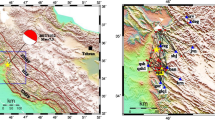Abstract
Source, propagation path and site conditions are the factors affecting seismic ground motion. Consequently, recordings acquired at a seismic station are formed by the convolution of these three factors. In this work S-wave acceleration Fourier spectra of earthquakes recorded at local and regional scale, by the ITSAK accelerometric network for the period 2010–2016, are modeled as a product of source, propagation path (including geometric and anelastic attenuation) and site effects. The data set consists of 136 crustal earthquakes occurred in the broader Aegean area, with magnitudes 4.2 ≤ Mw ≤ 6.5 and epicentral distances 20 km ≤ R ≤ 350 km, recorded at 112 broadband accelerometric stations installed at sites with various geologic conditions. Based on this data set, an iterative Gauss–Newton inversion method to solve the non-linear problem and retrieve the different terms of source, propagation path and site, is applied. This method uses an initial input model trying to find the best and at the same time a stable solution for the inverted parameters, which are, moment magnitude (Mw), corner frequency (fc), attenuation quality factor (Qs = Qofα), slope of the geometric attenuation (1/Rγ) and site transfer function (S(f)). The initial values of the starting model can be either known from other studies or inferred within a reasonable range. Depending on the level of knowledge on these input parameters, the associated standard deviation can be adjusted (large values for unknown parameters or small values for parameters which are well constrained). Results of the analyses exhibit satisfactory agreement of estimated source parameters with those proposed by seismological centers in Greece and propagation path properties similar to the ones determined in relevant previous studies for the same region. In addition, the site transfer functions obtained by the non-linear inversion are comparable with those calculated for the same sites using either standard spectral ratio or horizontal-to-vertical spectral ration (HVSR—receiver function) techniques. The aforementioned results are encouraging for reliable earthquake source parameters, propagation path properties and site effect assessment, in areas of intermediate to high seismicity.















Similar content being viewed by others
References
Aki K, Richards PG (2002) Quantitative seismology, 2nd edn. University Science Books, Sausalito, p 700
Andrews DJ (1986) Objective determination of source parameters and similarity of earthquakes of different size. Earthquakes source mechanics. Am Geophys Monogr 37:259–267
Atkinson G, Mereu R (1992) The shape of ground motion attenuation curves in southeastern Canada. Bull Seismol Soc Am 82:2014–2031
Bard P-Y, Bouchon M (1985) The two dimensional resonance of sediment-filled valleys. Bull Seismol Soc Am 75:519–541
Baskoutas I (1996) Dependence of coda Qc on frequency and lapse time in Central Greece. Pure Appl Geophys 147:483–496
Boatwright J, Fletcher JB, Fumal TE (1991) A general inversion scheme for source, site, and propagation characteristics using multiply recorded sets of moderate-sized earthquakes. Bull Seismol Am 81(5):1754–1782
Bonilla LF, Steidl JH, Lindley GT, Tumarkin AG, Archuleta RJ (1997) Site amplification in the San Fernado Valley, California: variability of the site-effect estimation using the S-wave, coda and H/V methods. Bull Seismol Soc Am 87(3):710–730
Boore D, Boatwright J (1984) Average body-wave radiation coefficients. Bull Seismol Soc Am 74(5):1615–1621
Boore DM, Joyner WB (1997) Site amplification for generic rock sites. Bull Seismol Soc Am 87(2):327–341
Borcherdt RD (1970) Effects of local geology on ground motion near San Francisco Bay. Bull Seismol Soc Am 60:29–61
Brune JN (1970) Tectonic stress and the spectra of seismic shear waves from earthquakes. J Geophys Res 75(26):4997–5009
Brune JN (1971) Correction. J Geophys Res 76(20):5002
Castro RR, Anderson JG, Singh SK (1990) Site response, attenuation and source spectra of S waves along the Guerrero, Mexico, subduction zone. Bull Seismol Soc Am 80:1481–1503
Chavez-Garcia FJ, Pedotti G, Hatzfeld D, Bard P-Y (1990) An experimental study of site effects near Thessaloniki (Northern Greece). Bull Seismol Soc Am 80:784–806
Drouet S, Chevrot S, Cotton F, Souriau A (2008a) Simultaneous inversion of source spectra, attenuation parameters and site responses: application to the data of the French accelerometric network. Bull Seismol Soc Am 98(1):198–219
Drouet S, Triantafyllidis P, Savvaidis A, Theodulidis N (2008b) Comparison of site-effects estimation methods using the Lefkas, Greece 2003 earthquake aftershocks. Bull Seismol Soc Am 98:1198–1219
Drouet S, Cotton F, Gueguen P (2010) Vs30, k, regional attenuation and Mw small magnitude events accelerograms. Geophys J Int 182(2):880–898
Drouet S, Bouin M-P, Cotton F (2011) New moment magnitude scale, evidence of stress drop magnitude scaling and stochastic ground motion model for the French West Indies. Geophys J Int 187:1625–1644
Field EH, Jacob KH (1995) A comparison and test of various site response estimation techniques, including three that are not reference site. Bull Seismol Soc Am 85(4):1127–1143
Futterman WI (1962) Dispersive body waves. J Geophys Res 67:5279–5291
Haghshenas E, Bard P-Y, Theodulidis N (2008) Empirical evaluation of microtremor H/V spectral ratio. Bull Earthq Eng 6:75–108
Hanks TC, Kanamori H (1979) A moment magnitude scale. J Geophys Res 84(B5):2348–2350
Hanks TC, McGuire RK (1981) The character of high-frequency strong ground motion. Bull Seismol Soc Am 71:2071–2095
Hashida T, Stavrakakis G, Shimazaki K (1988) Three-dimensional seismic attenuation structure beneath the Aegean region and its tectonic implication. Tectonophysics 145:43–54
Hatzidimitriou PM (1993) Attenuation of coda waves in northern Greece. Pure Appl Geophys 140(63–78):1993
Hatzidimitriou PM, Papazachos CB, Kiratzi AA, Theodoulidis NP (1993) Estimation of attenuation structure and local earthquake magnitude based on acceleration records in Greece. Tectonophysics 217:243–253
Herrmann R (1985) An extension of random vibration theory estimates of strong ground motions to large distances. Bull Seismol Soc Am 75:1447–1453
Karagianni EE, Papazachos CB (2007) Shear wave velocity structure in the Aegean region obtained by joint inversion of Rayleigh and Love waves. Geol Soc Lond Spec Publ 291:159–181
Karagianni EE, Papazachos CB, Panagiotopoulos DG, Suhadolc P, Vuan A, Panza GF (2005) Shear wave velocity structure in the Aegean area obtained by inversion of Rayleigh waves. J Geophys Res 160:127–143
Kastelic V, Kiratzi A, Benetatos C, Zivcic M, Bajc J (2010) Shear wave Q determination for the upper crust of Western and Central Slovenia. In: Proceedings of the XIX CBGA congress, Thessaloniki, Greece, vol 99, pp 377–385
Konno K, Ochmachi T (1998) Ground-motion characteristics estimated from spectral ratio between horizontal and vertical components of microtremor. Bull Seismol Soc Am 88(1):228–241
Kovachev SA, Kuzin IP, Shoda OY (1991) Attenuation of S waves in the lithosphere of the Sea of Crete according to OBS observation. Phys Earth Planet Inter 69:101–111
Lachet C, Hatzfeld D, Bard P-Y, Theodulidis N, Papaioannou C, Savvaidis A (1996) Site effects and microzonation in the city of Thessaloniki (Greece) comparison of different approaches. Bull Seismol Soc Am 86(6):1692–1703
Lermo J, Chavez-Garcia FG (1993) Site effect evaluation using spectral ratios with only one station. Bull Seismol Soc Am 83:1574–1594
Madariaga R (1976) Dynamics of an expanding circular fault. Bull Seismol Soc Am 66:639–666
Makra K, Raptakis D, Chavez-Garcia FJ, Pitilakis K (2001) Site effects and design provisions: the case of Euroseistest. Pure Appl Geophys 158:2349–2367
Makra K, Chavez-Garcia FJ, Raptakis D, Pitilakis K (2005) Parametric analysis of the seismic response of a 2D sedimentary valley: implications for code implementations of complex site effects. Soil Dyn Earthq Eng 25:303–315
Margaris BN, Boore DM (1998) Determination of Δσ and κο from response spectra of large earthquakes in Greece. Bull Seismol Soc Am 88:170–182
Margaris BN, Hatzidimitriou PM (2002) Source spectra scaling and stress release estimates using strong-motion records in Greece. Bull Seismol Soc Am 92:1040–1059
Margaris BN, Theodulidis NP, Papaioannou CA, Papazachos BC (1990) Strong motion duration of earthquakes in Greece. European Seis Commun, pp 865–870
Martin C (1988) Géométrie et cinématique de la subduction Egeene structure en vitesse et en atténuation sous le Péloponnése. These. Université Joseph Fourier, Grenoble
Maufroy E, Chaljub E, Hollender F, Bard P-Y, Kristek J, Moczo P, Martin F, Theodoulidis N, Manakou M, Guyonnet-Benaize C, Hollard N, Pitilakis K (2016) 3D numerical simulation and ground motion prediction: verification, validation and beyond—lessons from the E2VP project. Soil Dyn Earthq Eng 91:53–71
Nakamura Y (1989) A method for dynamic characteristics estimation of subsurface using microtremor on the ground surface. QR Railw Tech Res Inst 30(1):25–33
Nogoshi M, Igarashi T (1971) On the amplitude characteristics of microtremor (part 2). J Seismol Soc Jpn 24:26–40 (in Japanese with English abstract)
Novotny O, Zahradnik J, Tselentis G (2001) Northwestern Turkey earthquakes and the crustal structure inferred from surface waves observed in western Greece. Bull Seismol Soc Am 91(1):875–879
Papazachos CB (1992) Anisotropic radiation modeling of macroseismic intensities for the estimation of the attenuation structure of the upper crust in Greece. Pure Appl Geophys 138:445–469
Papazachos CB (1998) Crustal and upper mantle P and S velocity structure of the Serbomacedonian massif (Northen Greece). Geophys Res Lett 134:25–39
Papazachos BC, Margaris VN, Theodulidis NP, Papaioannou CA (1992) Seismic hazard assessment in Greece based on strong motion duration. 10 WCEE, Madrit, pp 425–430
Papazachos BC, Scordilis EM, Panagiotopoulos DG, Papazachos CB, Karakaisis GF (2004) Global relations between seismic fault parameters and moment magnitude of earthquakes. Bull Geol Soc Greece, XXXVI
PEER (2014) NGA-east: semi-automated procedure for windowing time series and computing Fourier amplitude spectra for the NGA-West2 database. Tadahiro Kishida, Olga-Joan Ktenidou, Robert B. Darragh and Walter J. Silva, Chapter 1, PEER report no. 2046/09, Pacific Earthquake Engineering Research Center, University of California, Berkeley, CA. June 2014
PEER (2016) NGA-east: semi-automated procedure for windowing time series and computing Fourier amplitude spectra for the NGA-West2 database. Tadahiro Kishida, Olga-Joan Ktenidou, Robert B. Darragh and Walter J. Silva, Chapter 2, PEER report no. 2016/02, Pacific Earthquake Engineering Research Center, University of California, Berkeley, CA. May 2016
Phillips WS, Aki K (1986) Site amplification of coda waves from local earthquakes in central California. Bull Seismol Soc Am 76:627–648
Poggi V, Edwards B, Fah D (2011) Derivation of a reference shear-wave velocity model from empirical site amplification. Bull Seismol Soc Am 101:258–274
Polatidis A, Kiratzi A, Hatzidimitriou P, Margaris B (2003) Attenuation of shear-waves in the back-arc region of the Hellenic arc for frequencies from 0.6 to 16 Hz. Tectonophysics 367:29–40
Scherbaum F, Wyss M (1990) Distribution of attenuation in the Kaoiki. Hawaii, source volume estimated by inversion of Pwave spectra. J Geophys Res 95:12439–12448
Scordilis EM, Kementzetzidou D, Papazachos BC (2016) Local magnitude calibration of the Hellenic Unified Seismic Network. J Seismol 20(1):319–332
Tarantola A (2005) Inversion problem theory and methods for model parameters estimation. SIAM, Philadelphia, p 342
Theodulidis N, Bard P-Y (1995) Horizontal to vertical spectral ratio and geological conditions: an analysis of strong motion data from Greece and Taiwan (SMART-1). Soil Dyn Earthq Eng 14:177–197
Triantafyllidis P, Hatzidimitriou PM, Theodulidis N, Suhadolc P, Papazachos C, Raptakis D, Lontzetidis K (1999) site effects in the city of Thessaloniki (Greece) estimated from acceleration data and 1D local soil profiles. Bull Seismol Soc Am 89(2):521–537
Wells DL, Coppersmith KJ (1994) New empirical relationships among magnitude, rupture length, rupture width, rupture area and surface displacement. Bull Seismol Soc Am 84:974–1002
Wessel P, Smith WHF (1998) New, improved version of generic mapping tools released. Eos Trans Am Geophys Union 79(47):579
Acknowledgements
We acknowledge support of this paper by the project “HELPOS—Hellenic Plate Observing System” (MIS 5002697), which is implemented under the Action “Reinforcement of the Research and Innovation Infrastructure”, funded by the Operational Programme; Competitiveness, Entrepreneurship and Innovation (NSRF 2014–2020) and co-financed by Greece and the European Union (European Regional Development Fund). We also express our acknowledgments at the team of the free software Generic Mapping Tools (http://gmt.soest.hawaii.edu/ Wessel and Smith 1998), used in this study for the digital maps creation.
Author information
Authors and Affiliations
Corresponding author
Appendices
Appendix 1
See Table 2.
Appendix 2
See Table 3.
Rights and permissions
About this article
Cite this article
Grendas, I., Theodoulidis, N., Hatzidimitriou, P. et al. Determination of source, path and site parameters based on non-linear inversion of accelerometric data in Greece. Bull Earthquake Eng 16, 5061–5094 (2018). https://doi.org/10.1007/s10518-018-0379-8
Received:
Accepted:
Published:
Issue Date:
DOI: https://doi.org/10.1007/s10518-018-0379-8




